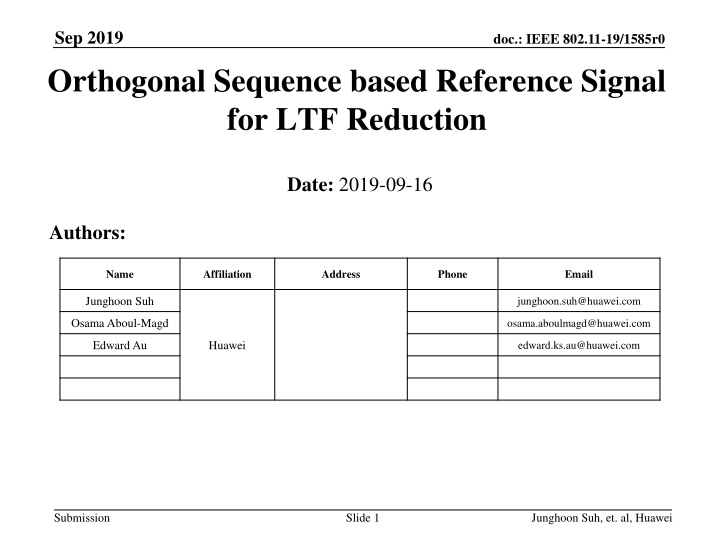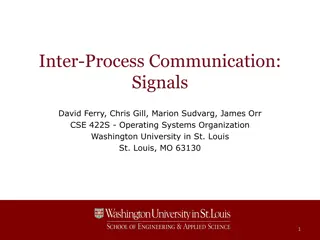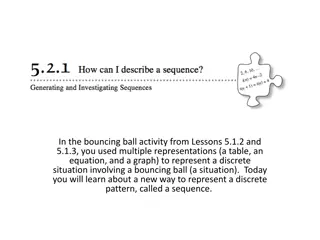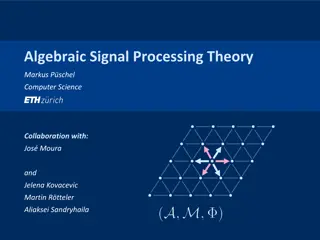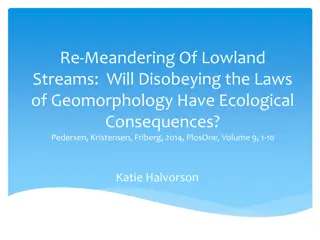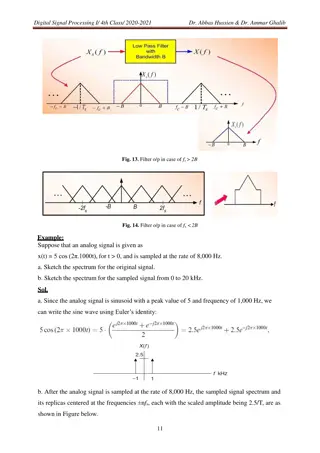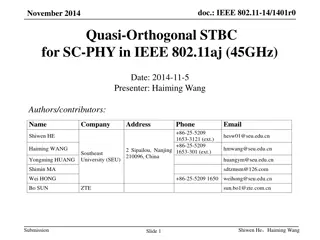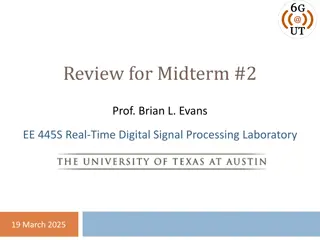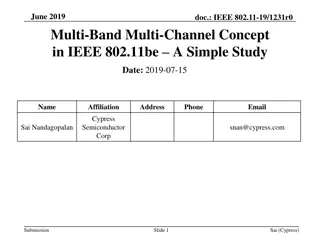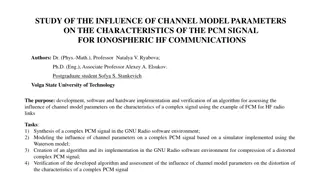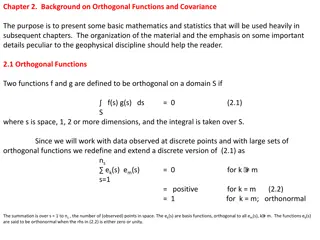Orthogonal Sequence-based Reference Signal Design for Multi-Stream Channel Estimation
Proposed Orthogonal Sequence-based Reference Signal (OSRS) for accommodating 16 streams in WLAN MIMO DL frame. Application to 802.11 MIMO systems with detailed 20 MHz Tone Plan. Simulation verification for OL SU-MIMO.
Download Presentation

Please find below an Image/Link to download the presentation.
The content on the website is provided AS IS for your information and personal use only. It may not be sold, licensed, or shared on other websites without obtaining consent from the author.If you encounter any issues during the download, it is possible that the publisher has removed the file from their server.
You are allowed to download the files provided on this website for personal or commercial use, subject to the condition that they are used lawfully. All files are the property of their respective owners.
The content on the website is provided AS IS for your information and personal use only. It may not be sold, licensed, or shared on other websites without obtaining consent from the author.
E N D
Presentation Transcript
Sep 2019 Orthogonal Sequence based Reference Signal for LTF Reduction doc.: IEEE 802.11-19/1585r0 Date: 2019-09-16 Authors: Name Affiliation Address Phone Email Junghoon Suh junghoon.suh@huawei.com Osama Aboul-Magd osama.aboulmagd@huawei.com Edward Au Huawei edward.ks.au@huawei.com Submission Slide 1 Junghoon Suh, et. al, Huawei
Sep 2019 doc.: IEEE 802.11-19/1585r0 Background Number of Spatial Streams will be extended to 16 streams in the EHT 16 LTFs necessary to support the 16 stream channel estimation according to the current 802.11 LTF schemes Maximum airtime for 16 LTFs can be as big as 256 usec with 4X LTF We need to come up with a new Reference Signal design to accommodate 16 streams We propose an Orthogonal Sequence based Reference Signal (OSRS) for the multi stream channel estimation In MIMO SC-FDMA, multiple access scheme for the UL transmission of cellular network, code- division multiplexed (CDM) pilots such as cyclic-shifted Zadoff-Chu sequences have been used for channel estimation. We want to apply the similar principle to the WLAN MIMO DL frame. Submission Slide 2 Junghoon Suh, et. al, Huawei
Sep 2019 doc.: IEEE 802.11-19/1585r0 OSRS An Orthogonal Sequence is assigned to each stream (??: i represents each stream) ?? ?? Received signal (? : ? = ?=0 The ?is obtained with the following inner product, ?= ?? Application to 802.11 For MU-PPDU, the number of tones where channel estimation is needed is 234 tones (26 tones (2 pilots included) * 9RU), excluding the DC and Nulls (22 tones) per 20 MHz Length of orthogonal sequences had better be 2 s power, and 4, 8 or 16 is the good sequence length 240 is divisible by 4, 8 or 16, and we can estimate the channel up to 240 using 4, 8 or 16 tone long Sequences E.g.) Each OFDM symbol may have 15 Segment based Orthogonal Sequences with length 16 ? 1 ???+?), for N streams, the ith stream channel parameter ?, and AWGN n ??/? Hadamard (16) can be used for the orthogonal Sequence There will be one estimated channel parameter per each 16 sub-carrier segment Hence, there will be 15 channel parameters available per 20 MHz OFDM Channel smoothing such as Linear Interpolation is required to obtain channel parameter per every subcarrier Submission Slide 3 Junghoon Suh, et. al, Huawei
Sep 2019 doc.: IEEE 802.11-19/1585r0 20 MHz Tone Plan for the OSRS Symbol: This tone plan can be applied to both MU and SU PPDU. Guard Tones Guard Tones DC .. .. 123 ~ 127 -2 -1 0 1 2 Tone Index -128 ~ -123 Hence, the tone index from -122 to -3 and from 3 to 122 will be used for OSRS. For example, 16 long sequence can be indexed as follows. Segment 3: -74 ~ -59 Segment 2: -90 ~ -75 Segment 0: -122 ~ -107 Segment 1: -106 ~ -91 Segment 7: -10 ~ -3 & 3 ~ 10 Segment 6: -26 ~ -11 Segment 4: -58 ~ -43 Segment 5: -42 ~ -27 Segment 11: 59 ~ 74 Segment 10: 43 ~ 58 Segment 8: 11 ~ 26 Segment 9: 27 ~ 42 Segment 14: 107 ~ 122 Segment 12: 75 ~ 90 Segment 13: 91 ~ 106 Submission Slide 4 Junghoon Suh, et. al, Huawei
Sep 2019 doc.: IEEE 802.11-19/1585r0 Simulation verification for OL SU-MIMO 4X4 Open-loop SU-MIMO 4 SS, 4 TX, 4 RX, QPSK and MMSE detection with BCC for FEC Packet size, 800 byte Scenario for Channel Estimation Reference Signal 11acLTF based (64 point OFDM symbol) 11ac based PPDU for data 11ax LTF based (256 point OFDM symbol; 4X LTF is used) 11ax based SU-PPDU for data OSRS with each segment length, 4 tones w/o interpolation There are 60 segments in an OFDM symbol Estimated Channel parameter per each segment are the same, that is, the same over every 4 tone OSRS with each segment length, 4 tones with interpolation There are 60 segments in an OFDM symbol Linear Interpolation is performed for those 60 estimated channel parameters to come up with 240 channel parameters for each 240 tones Submission Slide 5 Junghoon Suh, et. al, Huawei
Sep 2019 doc.: IEEE 802.11-19/1585r0 Linear Interpolation for Length 4 OSRS With No Interpolation Channel Parameters, `i represents segment index hi hi hi hi hi+1hi+1hi+1hi+1 hi+2hi+2hi+2hi+2 . . tn tn+1 tn+2 tn+3 tn+8tn+9tn+10tn+11 tn+4tn+5tn+6tn+7 Tone index With a Mid-tone Interpolation Chan. parameters obtained by Interpolation between hi+1and hi+2 Chan. parameters obtained by Interpolation between hiand hi+1 hi hi+1 hi+2 . . tn tn+2 tn+3 tn+1 tn+6 tn+5 tn+4 tn+10 tn+7 tn+11 Tone index tn+9 tn+8 We need to place the channel parameter obtained by the inner product (or correlation) with the corresponding orthogonal sequence onto a middle tone of the segment There are two middle tones in a segment because the segment length (orthogonal sequence length) is 2 s power It is ok to place the channel parameter obtained by the inner product onto either of these middle two tones before we run the interpolation, but needs to be consistent in each segment The same principle can be applied to any length of the sequence like length 8 or 16. Submission Slide 6 Junghoon Suh, et. al, Huawei
Sep 2019 doc.: IEEE 802.11-19/1585r0 Effect of Interpolation for OSRS: 4X4 OL SU-MIMO with Length 4 OSRS Submission Slide 7 Junghoon Suh, et. al, Huawei
Sep 2019 doc.: IEEE 802.11-19/1585r0 Effect of Interpolation for OSRS: 4X4 OL SU-MIMO with Length 8 OSRS Submission Slide 8 Junghoon Suh, et. al, Huawei
Sep 2019 doc.: IEEE 802.11-19/1585r0 Effect of Interpolation for OSRS: 4X4 OL SU-MIMO with Length 16 OSRS Mid Tone Interpolation is necessary when the Length of the OSRS is big. Submission Slide 9 Junghoon Suh, et. al, Huawei
Sep 2019 doc.: IEEE 802.11-19/1585r0 11ax based SU-PPDU used The longer the sequence, the better the performance, when there is no Beam-forming The length of the sequence can be regarded as a smoothing window size the larger the better Submission Slide 10 Junghoon Suh, et. al, Huawei
Sep 2019 doc.: IEEE 802.11-19/1585r0 For 256 tone LTF based RS with Smoothing, a moving average based smoothing (Window size 16 tone) is applied on top of a Least Square method of channel estimation The performance of using the OSRS is showing no degradation compared to the 802.11 LTF based RS design The gain is in the overhead Reduction: There are 4 LTFs but there is only one symbol for OSRS Submission Slide 11 Junghoon Suh, et. al, Huawei
Sep 2019 doc.: IEEE 802.11-19/1585r0 Simulations for the Beam-formed frame 16 TX MU-MIMO with 4, 6, and 8 STA MU-MIMO scheduling (2 streams each STA; 8, 12 and 16 total streams) 16 LTF symbol based Channel Estimation for 12 and 16 total streams (6 and 8 STA MU-MIMO case) 8 LTF symbol based Channel Estimation for 8 total streams (4 STA MU-MIMO case) 1 OSRS symbol for the Channel Estimation of 8 total streams (4 STA MU-MIMO case) Perfect sounding (No CSI Quantization error, No CSI feedback error, but real channel estimation using the 4X LTF based NDP) User Selection algorithm [1] to select from 8 total STAs for MU-MIMO scheduling Zero-forcing BF in the TX, and MMSE detection or Interference Whitening based MLD in each STA BCC for FEC MCS 1, 3, 5, and 7 Packet size for PER: 400 bytes for MCS 1, 3, 5, and 500 bytes for MCS 7 P-matrix for 16 Stream Channel Estimation in case of 16 LTF symbol based case ??????=???? ???? ???? ???? Submission Slide 12 Junghoon Suh, et. al, Huawei
Sep 2019 doc.: IEEE 802.11-19/1585r0 Phase Continuity When a beam-forming (BF) is applied to a data frame, the phase becomes discontinuous between data tones which makes the channel estimation through an interpolation very difficult We need to apply a Phase Continuity process during the Beam-forming in order to avoid the phase discontinuity problem The channel estimation during the sounding to measure the CSI information should be done through the 802.11 LTF based Reference Signal where the CSI information is obtained at every Ng and at every tone at last Let us denote P0 , P1 , P2 , to be a column vector of a pre-coding matrix per tone 0, 1, 2, etc., based on the CSI information obtained above then, the continuous phase based pre-coding column vector of a precoding matrix shall be ??, ??????, ??????, ??=-phase ?? ??=-phase ?? Repeat the procedure above ??? ???, where ?? here is the updated one with phase continuity, that is, ?????? Submission Slide 13 Junghoon Suh, et. al, Huawei
Sep 2019 doc.: IEEE 802.11-19/1585r0 User Selection for MU-MIMO [1] Since we have 16 Spatial Streams available, it is observed with the performance drop when all of the 16 Spatial Streams are fully used for the MU-MIMO scheduling and the Detection is MMSE Good User Selection is necessary to improve the performance We can check the correlation of two beamforming matrices with a covariance matrix check of any two pair For the case of two beamforming matrices ?1 and ?2 , Covariance matrix ? = ?1??2 Frobenious norm square ?? for the case of correlated ?1 and ?2 ?? The following are the User Selection algorithm used for the simulation in case of ZFBF 1. Check the magnitude of each STA s channel gains and Select the best STA 2. Check the orthogonality (Using the Frobenious norm square) of other STAs with the best STA selected in Step 1 3. Select the STA with the smallest Forbenious norm square in the Step 2 4. Check the orthogonality (Using the Frobenious norm square) of other STAs with the selected STA in Step 3 5. Select the STA with the smallest Forbenious norm square in the Step 4 Repeat the Step 4 and 5 for the rest of the User Selection 2 becomes close to zero in case of orthogonal ?1 and ?2, and becomes a big number 2 is obtained with each element of the matrix ? being squared and summed over all elements Submission Slide 14 Junghoon Suh, et. al, Huawei
Sep 2019 doc.: IEEE 802.11-19/1585r0 MCS 7 MCS 5 MCS 3 MCS 1 1 OSRS symbol for the Channel Estimation of 8 total streams (Red curve) vs. 8 LTF (4x LTF) symbol based channel estimation of 8 total streams (Blue curve) MMSE Detection Submission Slide 15 Junghoon Suh, et. al, Huawei
Sep 2019 doc.: IEEE 802.11-19/1585r0 Summary The larger the OSRS size is, the better performance is achieved, in case of Open Loop SU-MIMO, however, when BF is applied like MU-MIMO, we observed the shorter OSRS size performs better For 4X4 OL SU-MIMO, the Length 16 OSRS can be the most optimum choice for the sequence size For BF case such as MU-MIMO, the length 4 OSRS is better than the length 8 OSRS, and the length 8 OSRS is better than the length 16 OSRS OSRS is a good choice when the Inter-stream Interferences are very small such as 8 Stream MU-MIMO out of 16 available TX Very useful for the MU-MIMO when the degree of freedom in the available TX is large (e.g. 7 or 8 total stream MU-MIMO from 16 available TX) Submission Slide 16 Junghoon Suh, et. al, Huawei
Sep 2019 doc.: IEEE 802.11-19/1585r0 Reference [1] T. Yoo and A. Goldsmith, On the optimality of multiantenna broadcast scheduling using zero-forcing beamforming , IEEE Journal on Selected Areas in Communications, Vol. 24, March 2006 Submission Slide 17 Junghoon Suh, et. al, Huawei
